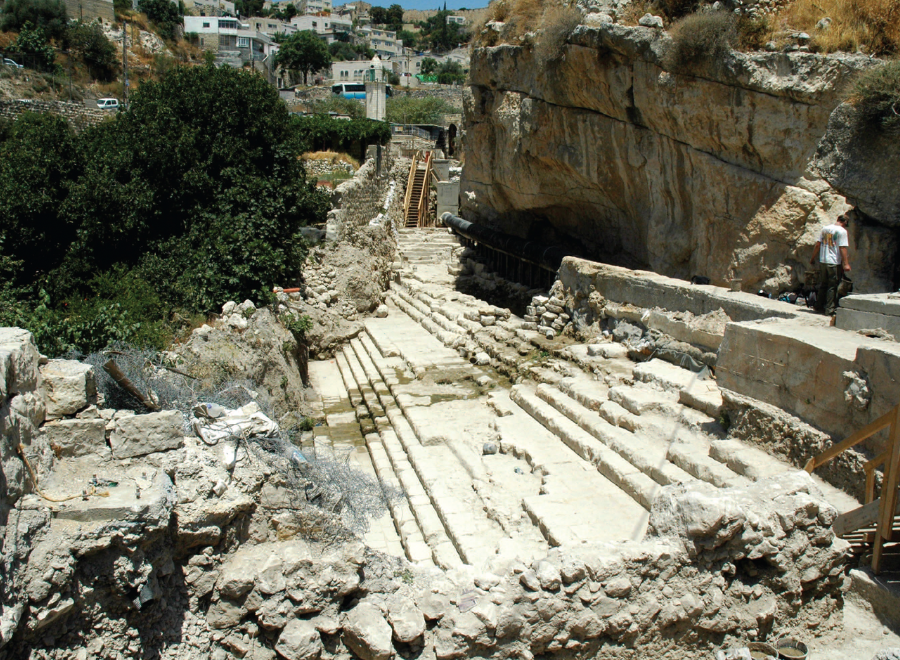Rev. Trisha Elliott explains that these six discoveries from ancient times are shedding new light on our spiritual roots.
The Oldest Christian Church
Two discoveries in the last decade staked claim to the title “Oldest Christian Church.” One was dug up in 2005 under an Israeli prison near Tel Megiddo; the other was found in 2008 beneath an ancient church in Rihab, Jordan. In the Megiddo prison, Ramil Razilo, one of dozens of inmates enlisted to excavate for a prison expansion, was moving rubble when he scraped his shovel across some tile. “We continued to look, and slowly we found this whole beautiful thing,” Razilo told reporters in 2005.
You may unsubscribe from any of our newsletters at any time.
Among the discoveries were a large mosaic floor with geometric patterns and fish symbols, a base in the floor’s centre that might have supported an altar, and an inscription reading “The God-loving Aketous has offered this table to the God Jesus Christ, as a memorial.” Archeologists estimate the site dates from the third or early fourth century.
Three years later, Abdul Qader al-Husan, head of Jordan’s Rihab Center for Archaeological Studies, claimed he found an even older church carved into a cave beneath an existing one. At a 2008 press conference, al-Husan announced, “We have evidence to believe this church sheltered the early Christians — the 70 disciples of Jesus Christ.”
His announcement was received with excitement and skepticism. “As for Jordan, no one is buying that it is a first-century church. Megiddo is different. The problem is whether it [Megiddo] is a place of worship, which it is, or whether it is a church,” says Joe Zias, former curator of the Israel Antiquities Authority. Some experts believe the site is actually a chapel within the home of a Roman officer named Gaianus, who is mentioned in an inscription.
“It was a private space,” says James Strange, a professor at the University of South Florida. “You would have had to be in the house to know it was there.”
Strange says the Megiddo site proves what scholars already know. “We know that, at the time, Christianity was illegal, that Christians worshipped in houses, and that very early on, Greek became the language of Christianity. Archeology is confirming what we know from reading [ancient] manuscripts.”
The Pool of Siloam
In 2004, Ronny Reich, an archeologist from the University of Haifa, got a call from his colleague Eli Shukron alerting him to a find. City workers excavating a sewage system on the southern edge of the City of David had just uncovered two ancient steps.
Hurrying to the site, Reich says he quickly realized that “the steps we found ascended to a rock cliff that went nowhere. We turned around and saw that they descended into a pool. Then the thoughts started to accelerate.”
Reich would later formally announce that his team had discovered the Pool of Siloam from Jesus’ time, where, according to the Gospel of John, Jesus healed a blind man.
The excavated side of the trapezoid-shaped pool is 69 metres long, with stairs — three sets of five steps, divided by landings — descending to the lowest level. Pottery and coins dating to the first century AD were found in the ruins, as well as coins in plaster from the first century BC. Reich believes that Jesus’ contemporaries would have ritually purified themselves in the pool before heading up the stone path to worship in the temple.
Since the 2004 discovery, Reich speculates that about 10 percent of the pool has been unearthed. The land covering the remainder of the pool is owned by a Greek Orthodox church. “I presented the discovery to the patriarch [of the church]. I haven’t heard anything since then,” says Reich.
Göbekli Tepe
Dating back nearly 12,000 years, Göbekli Tepe, located in Turkey, is the oldest architectural monument in the world, pre-dating the Egyptian pyramids and Stonehenge. Göbekli Tepe was flagged as an archeological site in a ground survey conducted in 1963, but its significance wasn’t realized until 1994, when a local farmer brought Klaus Schmidt, a member of the German Archaeological Institute, to the site. “I knew the importance of the place, but I didn’t know how large the architectural structures were until excavations began to reveal them,” says Schmidt.
Perched high on a mountain ridge, Göbekli Tepe (Turkish for “potbelly hill”) is a series of circular structures variously 10 to 30 metres across, each rimmed with large T-shaped monolithic pillars connected by walls made of coarsely stacked stones. Massive T-shaped pillars dot the centre of the circles.
While impressive for its age and size alone, Göbekli Tepe is equally remarkable for what it lacks: firepits, water reservoirs or any other evidence of human habitation. Instead, the site is strewn with animal bones, its monoliths carved with depictions of wild animals and symbols known to have religious significance in stone-age cave paintings.
Schmidt believes that Göbekli Tepe is the world’s oldest monumental sanctuary. He says animals were sacrificed in religious rituals there and speculates that it was a pilgrimage site for nomadic bands of hunter-gatherers. If Schmidt is right, the discovery of Göbekli Tepe will overturn previously held notions of religious history and civilization. “Initially we believed that first came the sedentary way of life, with animal husbandry and agriculture, and then other cultural achievements like architecture, sanctuaries and so on,” explains Schmidt. “As Göbekli Tepe is a place built and inhabited by hunters, this image changed. It seems now that religious beliefs drove people to construct monumental sanctuaries. The people who built them had to be fed, so bigger groups came together and switched to a more stable way of subsistence.
The James Ossuary
In 2002, the Royal Ontario Museum in Toronto showcased the only artifact known to establish the historical presence of Jesus: a 2,000-year-old limestone ossuary (a box that bones were placed in after the flesh had decayed) bearing the Aramaic inscription Ya’akov bar-Yosef akhui di Yeshua, or “James, son of Joseph, brother of Jesus.” But the flurry of interest gave way to allegations of forgery less than a year later, when the Israeli Antiquities Authority declared the ossuary a fake. In December 2004, Israeli antiquities collector Oded Golan and four other alleged conspirators were charged with running a forgery ring.
The controversy hinges on the last half of the inscription. While there is agreement that the ossuary itself dates back to the time of Jesus, some experts argue that the patina covering the “brother of Jesus” portion of the inscription doesn’t match the “James, son of Joseph” part.
But the debate doesn’t rest on the patina. Because the James Ossuary was purchased through the antiquities market rather than uncovered at an excavation where finds are heavily scrutinized in a controlled environment, old arguments have been raised about the review and authentication process. Critics charge that the archeological community didn’t have time to authenticate the ossuary before it was exhibited at the ROM.
In a 2003 press release, the ROM stated that the museum’s investigative team carried out studies on the artifact prior to its unveiling. Dan Rahimi, vice-president of gallery development at the ROM, says he continues to follow Golan’s case closely. “German scholars who are experts in patination are supporting the authenticity of both the ossuary and the inscription, but there hasn’t been a finding in the case. That’s what courts are for. We are waiting to see what the judge decides.”
The trial began in 2005 and ended last October. Judge Aharon Farkash is considering his verdict.
King Herod’s Tomb
“I cannot, in all honesty, conceal my desire to find the tomb of the Holy Land’s greatest builder, I shall nevertheless consider myself richly rewarded even if I continue to fail,” wrote Ehud Netzer in an article published in the Biblical Archaeology Review in 1983.
When he wrote those words, Netzer had already been searching for Herod’s tomb for over a decade — a quest that had eluded religious scholars and archeologists for over a century. The infamous king was responsible for killing his wife, three sons and, according to the book of Matthew, scores of male infants.
The most obvious clue to the missing tomb’s whereabouts came in the first century AD when Roman-Jewish historian Flavius Josephus reported that Herod’s body “was carried two hundred furlongs, to Herodium, where he had given order to be buried.” Although Herodium, the king’s extravagant complex built about 13 kilometres south of Jerusalem, was first excavated in 1956, Herod’s tomb would remain hidden for decades.
In 2007, Netzer’s perseverance was rewarded when his team discovered the tomb at Herodium between the upper and lower palaces. Inside, they found pieces of three sarcophagi (stone coffins), including a broken 2.5-metre-long pink sarcophagus embellished with carved rosettes.
While few doubt that the tomb belongs to Herod, there’s no definitive evidence that the ornate pink sarcophagus is his. “There’s no inscription to indicate that the sarcophagus belonged to Herod because fragments of more than one sarcophagus were found, and we don’t know who might have been buried with him,” says Jodi Magness, an archeologist at the University of North Carolina and Netzer’s former student.
Magness says that Netzer’s announcement about Herod’s tomb didn’t get the public attention it deserved. “In my opinion, it is the most important archeological find in Israel in the last decade It’s not just the tomb itself that is so significant. It’s that it tells us about how Herod himself wanted to be remembered. It gives us insight into who he was as a person.” Netzer died in 2010 at age 76 as a result of a fall at Herodium.
The Gospel of Judas
An Egyptian farmer found the Gospel of Judas in the 1970s, but it was sold twice, stolen once and stashed in shoe and safety-deposit boxes for over two decades before ending up at the Maecenas Foundation for Ancient Art in 2001, by which time the gospel had nearly disintegrated. Restoration experts and translators went to work, and the ancient text was publicly unveiled by the National Geographic Society in Washington, D.C., in 2006.
Dating back to the third or fourth century, the Coptic gospel — a translation of the original Greek Gospel of Judas — gives the Bible’s most notorious villain an extreme makeover. In the books of Matthew, Mark, Luke and John, Judas Iscariot is a traitor, selling out Jesus for 30 pieces of silver. In the Gospel of Judas, Jesus asks Judas to sacrifice him so that he can escape his earthly body.
In a press conference held during the unveiling, Bart Ehrman, distinguished professor of religious studies at the University of North Carolina, commented, “The reappearance of the Gospel of Judas will rank among the greatest finds from Christian antiquity and is without doubt the most important archeological discovery in the past 60 years.”
John Kloppenborg, chair of religious studies at the University of Toronto, says that while the gospel does seem to exonerate Judas, it’s important to understand the conceptual framework from which it arose. The gospel was developed by Sethians, Gnostic thinkers who tried to solve incongruities like why Jesus would choose as a disciple someone who would betray him. “It’s a really interesting document,” he says. “It doesn’t tell us anything about the historical Jesus or the historical Judas, though. It tells us about one way a group reimagined the Scripture. You could say that the Sethians were the first systematic theologians and that the Gospel of Judas reflects that.”
***
This story first appeared in The United Church Observer’s April 2011 issue with the title “Unearthing ancient secrets.”













